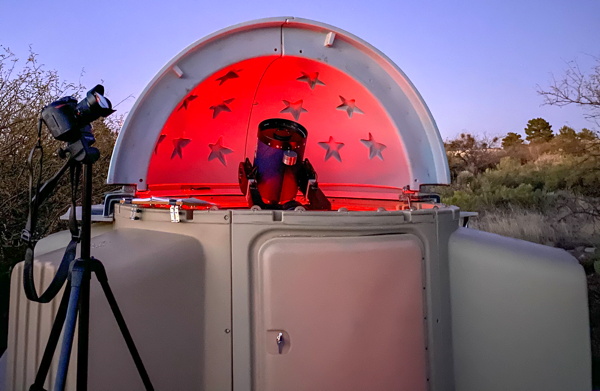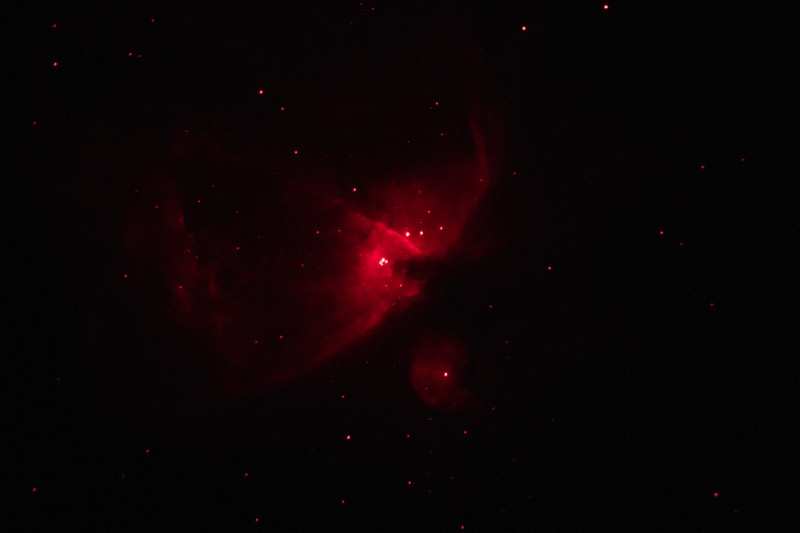SpaceX Starlink observations, Optolong SHO Orion Nebula,
Hubble's Variable Nebula
Posted: 14 January 2020
I purchased a Unihedron SQM-L meter that was received on Monday, 13 January 2020. I will be using it for Night Sky Quality readings at Cassiopeia Observatory and at other locations when I attend star parties. Readings will be submitted to the Globe at Night when appropriate.
|
Open: Monday, 13 January 2020, 1800 MST Temperature: 65°F |
Session: 1424 Conditions: Clear |
Equipment:
12" f/8 LX600 w/StarLock
2" 24mm UWA eyepiece
Camera:
D850 DSLR
I set up the D850 DSLR with a 14mm UWA lens on the observatory patio. I used it to do some test videos of SpaceX Starlink satellites from the third launch.

1826-1855 MST: I observed six Starlink satellites ranging in Magnitude from about +1 to +3. The satellite observations were spread out about every 3-5 minutes. No satellites "train" was seen. I did videos of the two satellites at Mag. +3, but while the satellites were recorded the videos were not quite good enough. By the time I saw the four brighter satellites (near the zenith) I had already removed the camera from the tripod. I will use a faster lens on my next attempt.
1843 MST: LX600 ON, StarLock OFF, High Precision OFF.
Viewed the planet Venus, 102X. Nice gibbous phase.
1904 MST: viewed M42 (the Great Nebula in Orion), 102X.
I then began preparing to image M42 using the Optolong SHO Narrowband Filters. I mounted the D850 DSLR at prime focus using the Starizona Filter Slider System.
1930 MST: took my first Night Sky Quality reading with the Unihedron SQM-L. It was 21.0. I have seen much darker skies at Cassiopeia Observatory so this reading was not typical.
Focused the 12" telescope on Rigel using the Meade Bahtinov Mask. Locked the 12" primary mirror using the ScopeStuff LX600 12" Primary Mirror Lock. Slewed to M42.
1940 MST: StarLock ON.
This is a StarLock autoguided image (slightly cropped) of the Orion Nebula without any filters (1 minute, ISO 3200).

I then took these images of M42 using the SHO filters.
HA, 1 minute, ISO 3200

OIII, 1 minute, ISO 3200

SII, 4 minutes, ISO 3200

The three images were edited, aligned, and merged in Photoshop, resulting in this image (slightly cropped).

2016 MST: High Precision ON.
Slewed to NGC2261 (Hubble's Variable Nebula). Took this StarLock autoguided image (no filters, 5 minutes, ISO 6400, cropped).

2025 MST: StarLock OFF, High Precision OFF.
Removed the camera and Filter System. Viewed NGC2261 (Hubble's Variable Nebula), 102X. Good view; looked like a comet.
2043 MST: LX600 OFF.
2046 MST: took another SQM reading. 21.1
|
Close: Monday, 13 January 2020, 2054 MST Temperature: 45°F SQM: 21.1, 2046 MST |
Session Length: 2h 54m Conditions: Clear |
Comments are welcome using Email. Twitter users can use the button below to tweet this report to their followers. Thanks.
Cassiopeia Observatory Home Page
Copyright ©2020 Michael L. Weasner / mweasner@me.com
URL = http://www.weasner.com/co/Reports/2020/01/14/index.html
